#vpc
Explore tagged Tumblr posts
Text
North node in the
Venus persona chart



Tells you about what you strive for in a romantic relationship, what your ideal relationship should entail & it even tells you about/reflect the relationship between you and your future spouse/ideal lover; what they're like.
This post is based on personal observations made on celebrity charts & people in my personal life. It's not the only way to look at this placement but I'll be focusing on the romance part for the sake of structure & simplicity. Also shows fated agendas related to your love life or beauty.

Northopalshores' masterlist| Venus persona chart masterlist| Briede persona chart | union persona chart masterlist| paid readings list
Please do not copy or reupload without my consent ʕ´•ᴥ•`ʔฅ🔉
₊ ˚ ⊹ ࣭ ⭑ . ₊ ⊹ .₊๋‧₊ ˚ ⊹ ࣭ ⭑ . ₊ ⊹ .₊๋‧₊ ˚ ⊹ ࣭ ⭑ . ₊ ⊹ .₊๋‧₊ ˚ ⊹ ࣭ ⭑ ⊹ .₊๋‧₊ ˚ ⊹ ࣭ ⭑
𖤝 Aries (°1,°13,°25) | 1st House
A love that is worth fighting for. A strong relationship that is independent of the type of love you've been surrounding yourself with. A ride or die type of love where you would do anything for your partner & they would do that too. A passionate, youthful love that never burns out. You may be quite addicted to the thrill that romance brings you and store a bit of affinity (though you may deny it) for some drama & action in your love life. A child-like romance where you bicker (for fun) then kiss & make-up. Your lover/future spouse needs to be a strong individual who has gone through quite a lot in their lives alone. Perhaps they felt like they had to grow up faster than their peers due to their responsibilities.
Ex: Blake Lively has this placement. In terms of her fashion choices well .. you know it's certainly "bold" in It Ends with us. She's still an icon in her own right due to her role in Gossip girl though.
💭 Possible fated agendas : Difficult love life (push & pull stubbornness), being "seen" through your striking beauty & the way you dress/groom yourself, making bold decisions in your love life & fashion
𖤝 Taurus (°2,°14,°26) | 2nd House
Stability is what you truly desire. What you yearn for in a relationship. You need a partner that is willing to compromise with you, and stick to their words; be there for you & the relationship no matter what happens. You desire someone who is strong and unwaivering & your partner may infact be quite the resources full & determined fellow! You may prefer a partner who is quite mellow and steadfast and prefers to do nothing with you than everything without.
Ex: One of my close friends has North node in Taurus °14 Taurus in the 4th house. Her current boyfriend (who I suspect to be her future spouse due to his surprising endurance & the fact that he matches literally every from what I've seen in her chart) is an immovable object to say the least. Once he says he really wants to do something, good lord he does it regardless of how tedious it may be. Man was stopped by hours or immigration related ordels but kept pushing through because he said he wanted to see her on Valentine's Day (it was their first time meeting each other face to face). Their date only lasted an hour because he had to work the next day. If that isn't determined, I don't know what is, damn.
💭 Possible fated agendas : Gaining money through art, fashion, beauty
𖤝 Gemini (°3,°15,°27) | 3rd House
You desire a relationship that is eye-opening. A relationship that feeds your curiosity & keeps you entertained. One where you never run out of things to say & share and discuss. A relationship that is fun and thrilling. An innocent "young love" type of energy. You love a partner that will see you and know exactly what you're thinking or what to say. A relationship where you can be as carefree, childish and teasing as much as you'd like. You desire a connection of the mind and that ringing, lingering echo of your laughs in your mind. Someone you don't have to be so serious around and can make "smart" (sarcastic) remarks at from time to time as a way to joke around.
Ex: Michael Jackson has North Node in Libra °5 Leo in the third house. Michael was a child at heart, and I do believe that what he strived for was a fun love life with his partner. Though he's not completely devoid of responsibility over his own actions being the cause of their separation (him & Lisa Presley), he did truly love her. He said that she understood him in the way that he hasn't felt before.
💭 Possible fated agendas : Expressing art/expression through your words, voice, being a singer, being a writer or a good poet, words essentially make up for your self esteem & who you want to be/are
𖤝 Cancer (°4,°16,°28) | 4th House
You desire a love that is safe & nurturing to the soul, one that allows you to embrace your femininity or your sensitive side more. A relationship that allows you to tear down your walls and let you freely be at peace with yourself & your emotions. A love that is mature & recognizes your feelings, and sensibility. You may desire a relationship that is quite tied to family or traditional values as well (regardless of sexuality), like having kids, pets and a nice home together. Daydreams surrounding being/having a lovely wife/spouse that understands your value and intentions. A protective & loving romance.
Ex: Beyoncé has North node in Cancer °27 in the 1st house (updated birth time). I think you can see this placement most on her. You can tell that she is a woman that loves femininity in every sense; embracing that powerful side of femininity as well. You can also see the same traits appearing in her love life; she loves the idea of being a wife & takes much pride in it as well. Just through listening to any of her love songs, you'll know what I mean. Also there's that famous quote from her claiming that he "made her a woman". I'm sure she meant every word. She's strong, she's beautiful, she's Sasha Fierce!
💭 Possible fated agendas : Starting a family, finding comfort though beauty & expression, lowering your guard and being content with yourself & your expressions
𖤝 Leo (°5,°17,°29) | 5th House
Fun. You need a relationship that brings out your inner child and that wildness in you. A love that gives you inspiration, and one that pushes you towards creativity & freedom of expression. A passionate and glorious type of love where you two are the shiniest rocks in the pile. Love, lust art and fun. I honestly think that this placement also gives you that need to be your partner's one & only; their world being centered around you and you being theirs. You may also have a deep desire to have children of your own or something that you can nurture with your spouse (or may look to them to reignite that childlike spark with how you act and see the words around you).
💭 Possible fated agendas : Being an artist, devoting yourself to performances (whether theater, music, painting or dance), devoting yourself to children
𖤝 Virgo (°6,°18) | 6th House
You desire and are drawn to relationships that build off of trust, mutual efforts and loyalty. The simplest things can make you very happy when you are in love, and what you need is a partner that is willing to do just as much for you as you would for them; even more! You naturally feel the need to dedicate yourself to your partner, giving them the time and attention that they need. However, that's only if your partner does the same for you! You have a practical sense when it comes to love and devotion. Though you are charmed by love, you will not be blinded by it. You want someone who can fit in with your lifestyle and is willing to work with. You may have a tendency to think you can fix your partner with just the right amount of good influence if you do end up with a fixer upper though, lol (ʕ´•ᴥ•`ʔ pls keep that feeling in check!)
💭 Possible fated agendas : your self expressions and artistic qualities showcased through work, working in the fashion or music industry




₊ ˚ ⊹ ࣭ ⭑ . ₊ ⊹ .₊๋‧₊ ˚ ⊹ ࣭ ⭑ . ₊ ⊹ .₊๋‧₊ ˚ ⊹ ࣭ ⭑ . ₊ ⊹ .₊๋‧₊ ˚ ⊹ ࣭ ⭑ ⊹ .₊๋‧₊ ˚ ⊹ ࣭ ⭑
𖤝 Libra (°7,°19) | 7th House
You desire a relationship that is romantic and thoughtful. This placement always comes with an innate sense of "put togetherness"; a proper relationship with a good amount of grace and eloquence. You need a relationship that you look good in (not necessarily for the sake of vanity, but a relationship that helps you blend with the sensible part of society). One where you are each others shining star in the blandest of scenarios. You need a love that is above all equal. You desire to be in a relationship that praises you for your grace and beauty, one that makes you feel beautiful & worthy.
💭 Possible fated agendas : being a style icon, devoting yourself to the fashion world/working with fashion, being in a specific relationship or related (likely through work) to certain people/company/group
𖤝 Scorpio (°8,°20) | 8th House
You have a great desire of a love that is passionate, powerful & unwavering. A love that takes from you just as much as you take from it. One where you can share anything with your partner; like your deep seated fears, worst behaviors, and well your sexual fantasies. You need a partner that you can be quite codependent with at times. Just needing them, and them needing you brings you a deep sense of love. Someone you can be selfish with & that can blow you away. Or well, you know just blow you lol. When in love, you want to share your mind, body and soul and everything else in between. Ideally, your partner will mirror that depth that you desire.
💭 Possible fated agendas : Transforming yourself through beauty, breaking norms surrounding love, beauty & fashion, tough relationships, transformation through your love life
𖤝 Sagittarius (°9,°21) | 9th House
You need a relationship that is enlightening. One where you share a fondness for humour. You may prefer to feel like you married your best friend; someone you can be yourself and goof around with. Someone you can always find yourself sitting on the same page with. A relationship that allows you to grow and learn and support you through any experience that life may bring your way. You need that support, understanding and spirit from your partner more than you'd prefer anything fancy or overly romantic ( even though you would appreciate it). What you yearn for in love ultimately, is a forever friendship and a partner you're free do explore with. Someone to guide you and teach you as well.
💭 Possible fated agendas : Honouring your cultural norms or aesthetic (traditional attire, makeup, culture), exploring expressions through religion and foreign cultures
𖤝 Capricorn (°10,°22) | 10th House
You need a relationship that will stand the harshest test of all; time. You desire love with maturity, perseverance, someone that can provide for you or someone worth providing for. Someone on your level when it comes to priorities and responsibilities. Someone that thinks of others (loved ones) before they think of themselves. You prefer someone that can keep you in the right direction and give you the proper guidance that you need. Someone that can take charge and take the burdens away from you (or alternatively someone that can depend on you and trust you with important things). Someone who sees your strengths and respects your way of life or expressions.
💭 Possible fated agendas : Stagnancy in self expression through fashion or art, being known for your craft (through art/expressions), acting, looking more mature and modest
𖤝 Aquarius (°11,°23) | 11th House
You desire a love that is different than the mundane. A love that is eye-catching, and silly but most of all genuine. A relationship that you can take of all your shiny shoes & waddle on home to knowing that they'll be happier to see you than whatever happened to your shoes in the first place. A relationship that misses your brain and not your looks or body in your absence. Though this placement also contributes to a love for the masses. Some people with this placement are quite amoured by the idea of fame and being seen (since Venus still talks about your expression as well; art, self etc) you may be in love with that idea of you becoming someone that people see.
Ex: Jay-Z has North node in Aquarius ° 28 Cancer in the 6th house, Taylor swift has North node in Aquarius °16 Cancer in the 5th house. Marilyn Monroe has North node in the 11th house.
💭 Possible fated agendas : Viral beauty, multiple admirers/suitors, revered for your love life/art/beauty/expression/your choice of partners or partnerships, style icon (in the 11th house specifically)
𖤝 Pisces (°12,°24) | 12th House
You are in love with love. The enamorous feelings of falling in love and getting to know them, being enchanted by your lover, finding that perfect person to complete your little story that you've built in your head. You are an extremist when it comes to the art of romance & expression; meaning that no matter who you see and what you do you look of "that person" in them. You may have felt a strong desire for a certain type of partner or partnership all your life & in a way have lived your life in love with something or someone you can't see. What you desire is true romance (no, not that horny movie starring Christian Slater) one with a happily ever after for you & your partner. One where you can get along on a deeper, more spiritual side with one another.
Ex: Elizabeth Taylor has north node in the 12th house & in Pisces! You can say what you want about her love life but she herself was a true romantic; constantly searching for the love of her life and someone that could sweep her of her feet. Love has been a large part of her life in both reputation & personal experiences. You can sort of say, she lived for love to some degree.
Matty Healy also has North node in pisces! Which is really, not surprising if you've read my post about him lolol
💭 Possible fated agendas : A confusing love life, multiple people being in love with you, being the one that got away, being the person that people do have a hard time moving on from
˚₊‧꒰ა paid readings available ໒꒱ ‧₊˚
₊ ˚ ⊹ ࣭ ⭑ . ₊ ⊹ .₊๋‧₊ ˚ ⊹ ࣭ ⭑ . ₊ ⊹ .₊๋‧₊ ˚ ⊹ ࣭ ⭑ . ₊ ⊹ .₊๋‧₊ ˚ ⊹ ࣭ ⭑ ⊹ .₊๋‧₊ ˚ ⊹ ࣭ ⭑


Thank you for reading ʕ •ᴥ•ʔ♡ support?
@northopalshore
@northopalshore venus persona chart 2025 all rights reserved. Disclaimer!
#north node in the venus persona chart#north node Venus persona chart#venus persona chart astrology#venus astrology#astrology blog#astrology notes#astrology observations#astro notes#astrology content#astrology#astro observations#astrology community#astrology ramblings#love life astrology#love astrology#fated romance astrology#self expression astrology#north node astrology#persona charts#venus pc#nn in venus persona chart#nn in vpc#vpc#astro community#astrology signs#live life astrology#venus#future spouse astrology
500 notes
·
View notes
Text
Vertex Persona Chart - Your Fate 🌟

Disclaimer: This post is for entertainment purposes only.
thealchemistbae © do not copy, redistribute, or edit my content.
If you enjoyed this post, you can leave me a tip via PayPal at [email protected] or via Venmo @goddessguapa. Thank you.
Bestie, if your birth chart is the map of your life, then your Vertex Persona Chart (VPC) is like the movie trailer for your fated encounters; aka, the people and moments that shift your entire path. Think of it as the chart that reveals the "meant to be" moments, the soulmate meetings, and the plot twists you never saw coming but were always written in the stars.

How to Read Your VPC Like a Cosmic Baddie:
One of the biggest keys to reading this chart? The houses. The house your Vertex lands in tells you where these fated experiences will happen, while the other planets in the chart show how you respond to destiny.
Houses - Where Fate Finds You
🌟: 1H -> Your fated moments revolve around identity, self-image, and personal power. When destiny calls, you undergo massive self-transformations and start stepping into a new version of yourself.
Karmic themes: Personal reinvention, major glow ups, finding your true path.
Fated people: Those who challenge or redefine who you are.
🌟: 2H -> Your biggest fated experiences involve money, security, and value. You may attract powerful opportunities that teach you about financial independence, abundance, and self-respect.
Karmic themes: Learning what's truly valuable; spiritually and materially.
Fated people: Mentors, business partners, or lovers who push you toward financial stability or self-worth lessons.
🌟: 3H -> Your destiny is tied to communication, ideas, and social connections. Fate brings important conversations, messages, and people who change your thinking.
Karmic themes: Expressing your truth, learning through key relationships, the power of words.
Fated people: Teachers, writers, influencers, or siblings who shift your perspective.
🌟: 4H -> Your karmic path is deeply tied to your home life, ancestry, and emotional security. Fate may bring family healing, relocation, or deep personal transformations.
Karmic themes: Releasing old family wounds, creating emotional stability, rediscovering your roots.
Fated people: Family members, soul family connections, or romantic partners who feel like "home".
🌟: 5H -> Your fate unfolds through romance, creativity, and self-expression. When destiny calls, you may experience soulmate level love, artistic breakthroughs, or moments of pure joy that shift your life.
Karmic themes: Love, fame, artistic gifts, inner child healing.
Fated people: Lovers, muses, or even children who bring deep meaning into your life.
🌟: 6H -> Your biggest fated moments are tied to health, work, and daily routines. You may be pushed toward a soul-aligned career, major lifestyle changes, or healing.
Karmic themes: Work that fulfills you, healing burnout, finding a sense of purpose.
Fated people: Coworkers, mentors, or healers who guide you toward personal growth.
🌟: 7H -> Your karmic path is woven into relationships; romantic, platonic, or business. Fate brings powerful one on one connections that feel meant to be.
Karmic themes: Love, commitment, divine partnerships, contracts.
Fated people: Soulmates, life partners, or business collaborators who change your destiny.
🌟: 8H -> Your destiny moments revolve around rebirth, intimacy, and shared resources. You may attract powerful, life changing relationships or financial shifts (like inheritance, investments, or debt).
Karmic themes: Deep emotional or financial transformations, personal empowerment.
Fated people: Lovers, spiritual guides, or financial partners who push you to evolve.
🌟: 9H -> Your fate is being tied to travel, spirituality, higher education, and big picture thinking. Your life changes when you step outside your comfort zone.
Karmic themes: Foreign lands, spiritual awakening, finding meaning in life.
Fated people: Mentors, foreign lovers, teachers, or guides who expand your perspective.
🌟: 10H -> Your destiny is closely tied to career, status, and long-term achievements. Fate may push you into the spotlight, leadership roles, or karmic career shifts.
Karmic themes: Fame, career milestones, life purpose realization.
Fated people: Bosses, authority figures, or public figures who play a major role in your journey.
🌟: 11H -> Your fated experiences happen through friendships, networking, and social influence. Your destiny is connected to your community, social movements, and manifesting your dreams.
Karmic themes: Finding your soul tribe, using your influence for good, aligning with your higher purpose.
Fated people: Friends, collaborators, or online connections who change your life.
🌟: 12H -> Your fate moments are deeply spiritual, hidden, or tied to past life karma. This is the house of divine timing, intuition, and deep transformation.
Karmic themes: Letting go of old cycles, psychic gifts, deep healing.
Fated people: Soulmates, past life connections, or spiritual mentors who awaken your true purpose.
Planets - How You React to Fate
The planets in your VPC show your role when destiny unfolds.
💫: Vertex -> The ultimate fated energy - your karmic "doorway" to change.
💫: Sun -> The core identity you step into during fated moments.
💫: Moon -> Your emotional response to destiny, intuition about fate.
💫: Mercury -> How communication and ideas shape your karmic path.
💫: Venus -> How love, beauty, and relationships play into fate.
💫: Mars -> How you take action toward destiny, passion driven fate.
💫: Jupiter -> Where you experience lucky, expansive, or big karmic shifts.
💫: Saturn -> Where fate teaches you lessons, long term karmic responsibilities.
💫: Uranus -> Where fate brings sudden, unexpected changes.
💫: Neptune -> Where fate brings illusions, spiritual awakenings, dreams.
💫: Pluto -> Where deep transformation. endings, and rebirth happen.
Few Random Aspects & Observations:
✨: Sun conjunct Pluto -> Fate transforms you completely. Your identity is constantly evolving through intense life changes. When destiny calls, you undergo major rebirths.
✨: Sun trine Jupiter -> You exude lucky, expansive energy. You naturally attract fortunate opportunities and fated blessings that elevate your success.
✨: Moon trine Uranus -> Fated emotional awakenings. Sudden events push you into unexpected yet freeing emotional experiences.
✨: Mercury square Neptune -> Be cautious with contracts, promises, and information. Fate may test you through misunderstandings, deception, or misleading messages.
✨: Venus sextile Saturn -> Your fated relationships tend to be serious; long term partnerships, marriage potential, and karmic lovers who bring stability.
✨: Mars conjunct MC -> Your career and public life are shaped by bold, fated actions. Destiny pushes you into leadership roles or high impact situations.
✨: Pluto sextile MC -> Your career and reputation go through fated transformations; expect rebirths, powerful connections, and moments of undeniable success.
✨: Uranus square Saturn -> You feel torn between stability and change. Fate forces you to break free from old structures and embrace new possibilities.
✨: NN conjunct MC -> Your destiny is public. Fate pushes you toward recognition, career milestones, and leadership.
✨: SN opposite Moon -> Past life emotional patterns resurface. You attract karmic connections that feel familiar but require emotional growth.
What You Get from Reading Your Vertex Persona Chart:
Where fate will strike & change your life (house placements).
What energies you embody when destiny calls (planets).
How your fated events unfold - challenges vs. blessings (aspects).
What kind of relationships & people are tied to your karma.
How to recognize and align with your biggest life changing moments.

thealchemistbae © do not copy, redistribute, or edit my content.
If you enjoyed this post, you can leave me a tip via PayPal at [email protected] or via Venmo @goddessguapa. Thank you.
Your Vertex Persona Chart reveals when and how fate steps in and shakes up your life. Aspects show the themes of your destiny, who enters your life, and what kind of major events you're bound to experience. Keep an eye on transits hitting your Vertex points; that's when the magic (or chaos) really unfolds.
#astrology#astro observations#astro community#thealchemistbae#birth chart#horoscope#astrology for beginners#natal chart#vertex#vertex persona chart#persona charts#persona chart#astro notes#vpc
441 notes
·
View notes
Text
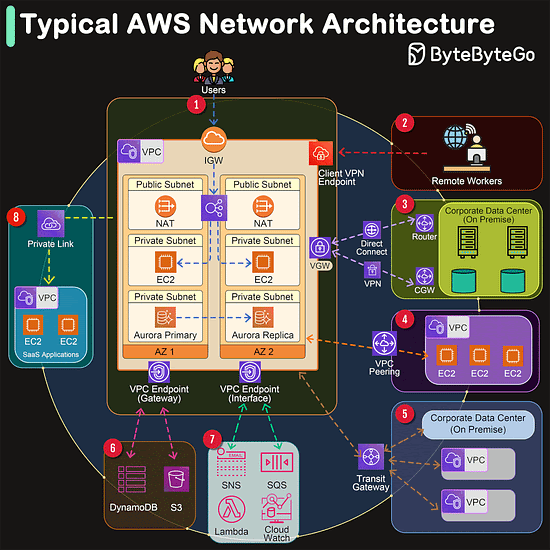
4 notes
·
View notes
Text
Virtual Private Cloud (VPC) Flow Logs in Amazon Web Services (AWS) is an indispensable feature for developers, network administrators, and cybersecurity professionals. It provides a window into the network traffic flowing through your AWS environment, providing the visibility needed to monitor, troubleshoot, and secure your applications and resources efficiently.
2 notes
·
View notes
Text
Everything To Know About Value Proposition Canvas (VPC)
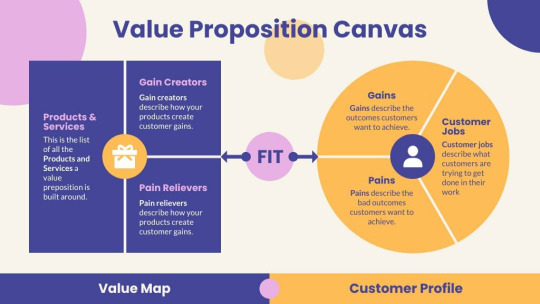
WHAT IS A VALUE PROPOSITION CANVAS?
The Value Proposition Canvas is a valuable tool used to gain a deeper understanding of your customers and create a compelling value proposition for your product or service. It begins by identifying the needs of your target customers, which can be both functional and emotional in nature. These are the things your customers actively seek or desire. Simultaneously, it's crucial to grasp their pains or challenges, which are the problems and inconveniences they encounter in their lives. Pains can be related to cost, time, effort, risks, or other hindrances.
With a clear understanding of customer needs and pains, you can then analyze how your product or service can effectively address these issues. This involves highlighting the features, capabilities, and attributes of your offering that directly alleviate customer pains and fulfill their needs. This alignment between what the customers seek and what your product provides is where the value proposition comes into play.
The value proposition is the central element of this framework, serving as a promise to your customers that your product will satisfactorily meet their needs and alleviate their pains. It's a concise and compelling statement that communicates the unique value your product offers to customers. In essence, it answers the question: "Why should a customer choose our product over alternatives?" This value proposition assures potential customers that they will gain value from using your product, ultimately increasing the likelihood of successful product adoption.
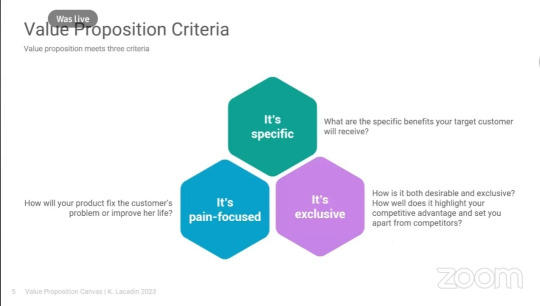
VALUE PROPOSITION CRITERIA
IT'S SPECIFIC
A specific value proposition effectively conveys the merits and benefits of your product or service without resorting to vague or generic language. It is tailored to a clearly defined target audience, addressing their specific needs and desires. This level of specificity aids potential customers in gaining a clear understanding of what they can anticipate from your offering.
IT'S PAIN-FOCUSED
A value proposition centered on addressing pain points identifies and tackles the specific issues or difficulties that your intended customers encounter. It showcases how your product or service can ease these pain points or offer solutions. This understanding and empathy for your customers' challenges enable you to establish a deeper connection with them.
IT'S EXCLUSIVE
An exclusive value proposition emphasizes the unique qualities that set your product or service apart from competitors. It effectively conveys the reasons why customers should select your offering over alternatives available in the market. This distinctiveness can arise from various aspects, including features, advantages, quality, or any distinguishing factor that differentiates your offering.
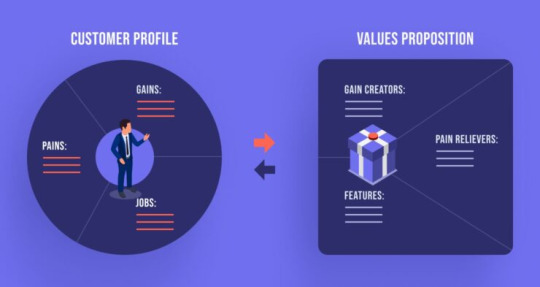
TWO CATEGORIES OF VALUE PROPOSITION CANVAS
CUSTOMER PROFILE
A customer profile is a fundamental component of any business or marketing strategy, with its primary focus on gaining a deep understanding of the customer's perspective. It involves the systematic collection and analysis of pertinent information to construct a detailed and comprehensive portrait of the typical or ideal customer for a product or service. This profile encompasses various dimensions, including demographic details like age, gender, location, income, and occupation, providing the foundation for effective customer segmentation. Furthermore, it delves into psychographic information, exploring lifestyle, values, interests, and behaviors, painting a holistic picture of customer motivations and aspirations.
In addition to demographic and psychographic data, a well-constructed customer profile delves into the specific needs and pain points of the customer. It seeks to uncover the problems customers are attempting to solve and their overarching goals. By identifying these aspects, businesses can position their products or services as effective solutions, creating a stronger connection with the customer.
Understanding the customer's buying behavior is another critical facet of a customer profile. This entails analyzing the processes and factors that influence their purchasing decisions. It helps businesses align their marketing and sales strategies with the preferences and habits of their target audience. Also, customer profiles encompass insights into how customers prefer to communicate with brands and their interactions with competitors, offering a comprehensive view of their engagement preferences and potential gaps in the market.
VALUES PROPOSITION/MAP
The "Value Map" is an integral part of any well-structured business strategy, serving as the connective tissue between a customer profile and the product or service being offered. It plays a vital role in detailing how the offerings align with the characteristics, needs, and preferences of the target audience as identified in the customer profile. This alignment is a strategic imperative, as it helps businesses develop a clear and compelling value proposition that resonates with their customers. By establishing this connection, the value map accomplishes several key objectives.
Firstly, it bridges the gap between customer requirements and the product's attributes, ensuring that the offerings effectively meet the needs, desires, and pain points discerned from the customer profile. Secondly, it enables businesses to tailor their value proposition in a way that speaks directly to the specific attributes most valued by their audience. The value map is not just about addressing customer needs but doing so in a manner that distinguishes the offering from competitors. This involves emphasizing unique selling points, whether they involve distinctive features, superior quality, cost-effectiveness, or any other factors that set the product apart.
Furthermore, the value map lays the groundwork for crafting a persuasive value proposition. This proposition is a concise and compelling statement that communicates the distinct value the product provides to the customer. It assures potential customers that the offering will fulfill their needs and alleviate their pains. Importantly, the value map is not a static document; it's part of an ongoing, iterative process. Businesses continuously refine their offerings to ensure that they remain closely aligned with customer expectations. By actively monitoring customer feedback and staying attuned to market trends, businesses can adapt their value maps to maintain relevance and competitiveness.
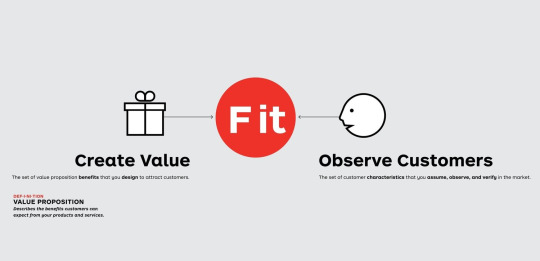
HOW TO CREATE A WINNING VALUE PROPOSITION
Step 1: Research Your Audience
In any successful marketing strategy, understanding your target audience is paramount. This involves delving deep into your potential customers' demographics, behaviors, preferences, and pain points. By doing so, you gain insights into what motivates them, what problems they need solutions for, and how your product or service can address these needs. This knowledge is essential for crafting effective marketing messages that resonate with your audience. It also allows you to pinpoint the selling points of your product or service, enabling you to tailor your communication in a way that highlights its unique benefits and value to your target market.
Step 2: Create an Ideal Buyer Persona
Once you've gathered extensive data about your audience, the next step is to distill this information into ideal buyer personas. A buyer persona is a semi-fictional representation of your ideal customer, and it encompasses key traits, behaviors, and preferences. Analyzing the qualitative data collected from your audience research allows you to identify patterns and commonalities among your potential customers. Creating different personas based on these patterns helps you categorize your audience into segments. This segmentation is valuable because it allows you to personalize your marketing efforts, tailoring your messages and offerings to suit the specific needs and desires of each persona. In essence, it makes your marketing more precise and effective.
Step 3: Research Your Competitors
Competitor research is not about undermining your competition, but rather, it's about gaining a comprehensive understanding of the market landscape. By studying your competitors, you can learn from their successes and failures, identify trends, and uncover opportunities for innovation. This step is essential for discovering a unique edge or advantage over the current offerings in the market. It involves analyzing your competitors' products, marketing strategies, pricing, customer feedback, and any gaps or weaknesses in their approach. This information can guide your own innovation and help you position your product or service more effectively.
Step 4: Determine the Primary Benefit of Your Product
The last step is you need to identify the core advantage of your product including the main value it provides to your customers. This primary benefit is the key reason why someone would choose your product over alternatives. It's essential to understand and clearly communicate this benefit in your marketing efforts.
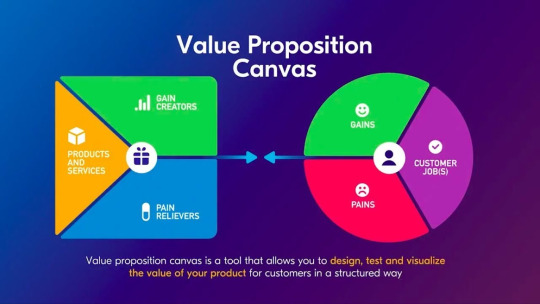
SUMMARY
he Value Proposition Canvas (VPC) is a powerful tool used to gain a deep understanding of customers and create a compelling value proposition for a product or service. It involves identifying customer needs and pains, which can be both functional and emotional. Needs are what customers actively seek, while pains are the problems and inconveniences they encounter. The VPC then guides you to analyze how your product can effectively address these issues by aligning its features with customer needs and pains. The value proposition serves as a promise to customers, assuring them that your product will meet their needs and alleviate their pains.
A winning value proposition should be specific, pain-focused, and exclusive. It should convey the merits and benefits of your product or service in a clear and tailored manner, addressing the specific needs and challenges of your target audience while emphasizing what sets your offering apart from competitors.
The process involves two categories: the Customer Profile and the Value Map. The Customer Profile delves into customer demographics, psychographics, needs, pain points, and buying behavior. The Value Map connects this customer understanding with your product's attributes, ensuring alignment with customer expectations. It also helps create a concise and compelling value proposition.
CONCLUSION
Creating a strong value proposition is essential for any business aiming to succeed in a competitive marketplace. The Value Proposition Canvas provides a structured approach to understanding customer needs and pains, aligning them with your product's features, and crafting a persuasive value proposition. By researching your audience, creating ideal buyer personas, and researching your competitors, you can gather the insights necessary to differentiate your product and communicate its unique value effectively. Ultimately, a well-crafted value proposition not only attracts potential customers but also fosters a deeper connection by addressing their specific needs and challenges, setting the stage for successful product adoption and business growth.
Written by: Jovy Rañesis
2 notes
·
View notes
Text


Explore the essential components of VPC and learn configuration best practices through detailed lab exercises. https://www.dclessons.com/labconfiguring-vpc-its-components
0 notes
Text
Tại Sao Nên Dùng Bồn Composite Xử Lý Nước Thải Trong Các Công Trình Xây Dựng?
Tại Sao Nên Dùng Bồn Composite Xử Lý Nước Thải Trong Các Công Trình Xây Dựng?
Trong các công trình xây dựng hiện đại, việc xử lý nước thải hiệu quả là yếu tố then chốt để bảo vệ môi trường. Bồn composite xử lý nước thải là lựa chọn lý tưởng nhờ khả năng chống ăn mòn, độ bền cao và tuổi thọ vượt trội. Với thiết kế gọn nhẹ, dễ lắp đặt, sản phẩm giúp tiết kiệm chi phí thi công và bảo trì.
Đặc biệt, bồn composite từ Việt Phát Composite được sản xuất theo công nghệ tiên tiến, đảm bảo tiêu chuẩn kỹ thuật và phù hợp nhiều loại công trình: nhà máy, khu dân cư, khu công nghiệp...
Hãy lựa chọn giải pháp tối ưu cho hệ thống xử lý nước thải ngay hôm nay!
Liên hệ Việt Phát Composite: 0969 883 186 #vietphatcomposite #boncompositexulynuocthai
0 notes
Text
Buy Now Flying Probes From Equip Test
The concept of a flying probe test that accesses components on printed circuit assemblies (PCAs). Flying probe upgrades bed of nail fixture and takes advantage of probes to replace bed of nails. The flying probe technology tests the boards without using a special bed of nails adapter. For more information visit https://bit.ly/3yq0wgP
#test probes#spring contact probes#ingun test probes#RF testing#radio frequency testing#Flash Fixture#Flying Probes#IPTE#mass interconnect#sockets#FCT#VPC#Interface#Test Socket#spring loaded contact probes#receptacles#Flash programming#Functional Test#kelvin probe#ICT
0 notes
Text
What Is Amazon Virtual Private Cloud VPC? Benefits, Features

What is Amazon VPC?
AWS resources can be launched in a logically isolated virtual network that you specify using the Amazon Virtual Private Cloud (VPC) service. You are in total control of your virtual networking environment, including choosing your own range of IP addresses, setting up subnets, and configuring network gateways and route tables. The majority of the resources in your VPC are compatible with both IPv4 and IPv6, which helps to provide safe and convenient access to resources and apps.
Customizing the network setup of your VPC is simple using Amazon VPC, one of AWS’s core services. For your web servers with internet connection, you can set up a subnet that is visible to the public. Additionally, it enables you to locate your backend systems like databases or application servers in a subnet that faces the private sector and is not connected to the internet. Several security layers, such as network access control lists and security groups, can be used with Amazon VPC to assist manage access to Amazon Elastic Compute Cloud (Amazon EC2) instances within each subnet.
Benefits of Amazon VPC
Increase security
Within your virtual network, secure and keep an eye on connections, filter traffic, and limit instance access.
Save time
Reduce the amount of time you spend configuring, maintaining, and verifying your virtual network.
Manage and control your environment
Create subnets, configure route tables, and select your own IP address range to personalize your virtual network.
How it works
You have complete control over your virtual networking environment with Amazon Virtual Private Cloud (Amazon VPC), including connectivity, security, and resource placement. Set up your VPC in the AWS service panel to get started. Add resources like Amazon Relational Database Service (RDS) instances and Amazon Elastic Compute Cloud (EC2) after that. Lastly, specify how your VPCs interact with one another across AWS Regions, Availability Zones, and accounts.
Use cases
Launch a simple website or blog
Enforce restrictions on inbound and outbound connections to strengthen the security posture of your web application.
Host multi-tier web applications
Establish network connectivity and limitations among your databases, application servers, and web servers.
Create hybrid connections
Create and oversee a VPC network that works with both your on-premises and AWS services.
Amazon virtual private cloud pricing
Why Amazon Virtual Private Cloud?
Although setting up and utilizing an Amazon Virtual Private Cloud (VPC) is free, you can pay for its extra features using usage-based fees. You may modify your Amazon VPC’s control, connectivity, monitoring, and security with the help of AWS’s tools and services. Please refer to the following for precise pricing rates for these components.
There are still usage fees associated with other Amazon Web Services products, like Amazon Elastic Compute Cloud (Amazon EC2), which include data transfer fees. Pricing is per VPN connection-hour if you use the optional hardware virtual private network (VPN) connection to link your VPC to your corporate data center. Data transported across VPN connections will be invoiced at standard AWS Data Transfer rates, and partial hours are billed as full hours.
Amazon VPC features
Logs of Flow
To get operational insight into your network dependencies and traffic patterns, identify irregularities and stop data leaks, and troubleshoot network connectivity and configuration issues, you can keep an eye on your Amazon Virtual Private Cloud (VPC) flow logs that are sent to Amazon Simple Storage Service (Amazon S3) or Amazon CloudWatch. You can discover more about who started your TCP connections and the packet-level source and destination of traffic passing through intermediary layers by examining the expanded information in flow logs. To help you ful fill some compliance obligations, you can additionally archive your flow logs.
IP Address Manager (IPAM)
Planning, tracking, and monitoring IP addresses for your AWS workloads is made simpler with IPAM. IPAM eliminates the need for spreadsheet-based or in-house planning software by automating IP address assignments to your Amazon Virtual Private Cloud VPC. Additionally, it improves network observability by displaying IP utilization across several VPCs and accounts in a single operational view.
IP Addressing
Resources in your VPC can communicate with resources over the internet and with each other thanks to IP addresses. Both IPv4 and IPv6 addressing protocols are supported by Amazon Virtual Private Cloud (VPC). IPv4-only, dual-stack, and IPv6-only subnets can be created in a VPC, and Amazon EC2 instances can be started in these subnets. Additionally, Amazon offers you a variety of choices for giving your instances public IP addresses. You can use an IP address from the Amazon-provided IPv6 CIDRs, Elastic IPv4 addresses, or public IPv4 addresses. In addition, you have the choice to assign these instances your own IPv4 or IPv6 addresses within the Amazon VPC.
Ingress Routing
This functionality allows you to redirect all incoming and outgoing traffic to and from a virtual private gateway or internet gateway to the elastic network interface of a particular Amazon EC2 instance. Before any traffic reaches your business workloads, route it to a gateway or an Amazon EC2 instance in your Amazon Virtual Private Cloud (VPC).
Network Access Analyzer
You can confirm that your network on AWS complies with your network security and compliance requirements by using Network Access Analyzer. With the help of Network Access Analyzer, you may define your standards for network security and compliance and find unauthorized network access that doesn’t fit your needs. With the help of Network Access Analyzer, you can comprehend network access to your resources, find ways to strengthen your cloud security posture, and quickly show compliance.
Network Access Control List
An optional security feature for your VPC is a network access control list (network ACL), which functions as a firewall to regulate traffic entering and leaving one or more subnets. Network ACLs can be configured using rules that are comparable to those in your security groups.
Manager of Networks
To assist you in managing and keeping an eye on your network on AWS, Network Manager offers capabilities and tools. IP administration, network security and governance, connectivity management, and network monitoring and troubleshooting are all made simpler with Network Manager.
Analyzer of Reachability
You can examine and troubleshoot network reachability between two resources in your VPC using this static configuration analysis tool. When the source and destination resources are reachable, Reachability Analyzer generates hop-by-hop information about the virtual path between them; when they are not, it identifies the blocking factor.
Security Groups
Establish security groups to regulate incoming and outgoing traffic at the instance level, serving as a firewall for related Amazon EC2 instances. An instance can be linked to one or more security groups at the time of launch. The instance is automatically linked to the VPC’s default group if you don’t specify a group. In your VPC, each instance may be a member of a distinct group.
Mirroring of Traffic
With this capability, you can transfer network traffic to out-of-band security and monitoring appliances for deep packet inspection after copying it from an elastic network interface of Amazon EC2 instances. You may create security and compliance controls, troubleshoot problems, obtain operational insights, and identify network and security anomalies. You can directly view the network packets passing through your VPC with traffic mirroring.
Lattice
You can reliably connect, keep an eye on, and protect conversations between your apps with the aid of this service. Network traffic control, access, and monitoring policies can simplify and standardize compute service connections across instances, containers, and serverless apps.
Public Access Is Blocked by VPC
This feature ensures that resources in your Amazon Virtual Private Cloud (VPC) are not accidentally exposed to the public by offering a single declarative control that makes it simple to prevent direct Internet access VPCs via the Internet Gateway or Egress-only Gateway. You can choose to ban only ingress Internet connections or both egress and ingress Internet connections in the VPC.
Read more on Govidhtech.com
#AmazonEC2#AmazonVirtualPrivateCloud#VPC#AmazonVPC#IPaddresses#EC2instances#News#Technews#Technology#Technologynews#Technologytrends#Govindhtech
0 notes
Note
What does it mean to have scorpio moon at 0 degree in venus persona chart? Is it a bad thing?(I have this and I'm curious)
Also, will you make a post about venus pc in the future? I love your astrology posts btw!
Have a good day!
𝄞⨾𓍢ִ໋ Hello!
I'm currently working on a few Venus & Boda persona chart posts for my new corresponding persona chart Masterlist ᕦʕ •ᴥ•ʔᕤ!
Moon in the Venus persona chart can be seen in two ways; love partnerships & self love. It's what you're most secure & stable with. How you feel loved & feel comfortable in your own skin.
I don't think your placement is bad at all.
The °0 degree isn't particularly attached to any other zodiac sign, but it does act as an enhancer ; focus on the sign & house this placement is!
With VPC Moon in Scorpio (°0), you feel most loved when you're protecting your energy or in a relationship that values your privacy & boundaries. Self love & satisfaction from the material/beauty world comes from a sense of ownership and exclusivity. Feeling or looking untouchable in a way. You aren't fond of sharing about yourself of your love life or even things that you own with others. That's because that is your safe space & it is rightfully yours.
pay attention to where it is in the chart as well (which house) since it brings more clarification to this placement.
Hope this helps ♡
#venus persona chart#moon in the venus persona chart#moon in Scorpio#°0 degree in astrology#astrology observations#astrology notes#astrology blog#astro notes#astro observations#astrology content#astrology#astrology community#astrology ramblings#venus#vpc#venus persona chart moon sign#Scorpio moon in vpc
17 notes
·
View notes
Text
Is AWS Elasticsearch Developer’s True Hero?

Elasticsearch is a free open source search engine, which is used for log analytics, full-text search, application monitoring and more. It makes easy to deploy, operate and scale Elasticsearch clusters in the AWS Cloud. We can get direct access to the Elasticsearch APIs. It provides Scalability, Availability and Security for the workload process run.
Elasticsearch architecture
The AWS Elasticsearch Service Architecture is very dynamically to allow create instances, remove instances, change instance sizes, change storage configuration and customize to make other changes. This Elasticsearch allows to search and analyse the data log. It consists of three components.
Logstash – is used to collect and transferred to the Elasticsearch.
Elasticsearch –facilitates search and analyze with the logs stored in it. It acts as a database.
Kibana –Kibana enables the data visualization on the dashboard that uses ELK stack. This tool provides a quick insight of the documents using visualization Kibana’s dashboard contains interactive diagrams, geospatial data, and graphs to visualize complex queries that let you search, view, or interact with the stored data. Kibana helps you to perform advanced data analysis and visualize your data in a variety of tables, charts, and maps.

Get started with an Elastic Cluster with AWS
First, create an AWS account and follow the following steps to claim your domain.

Tap on to “Create a new domain”
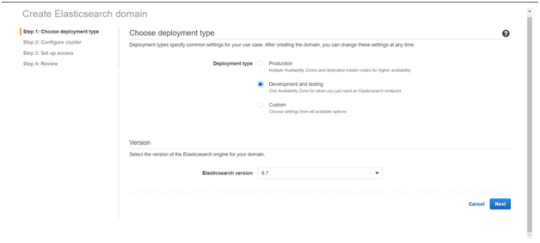
Select on the appropriated Deployment type and select the Elasticsearch version. Click Next.
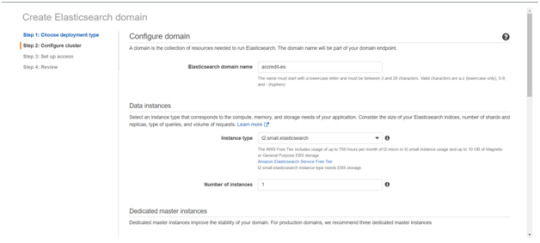
Enter a domain name and choose the Instance type in the prompt page and Click Next.
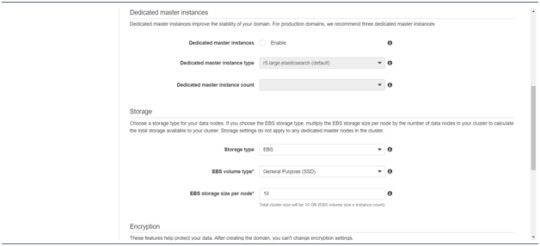
Follow to enter the “Dedicated master instances”

Click Next.
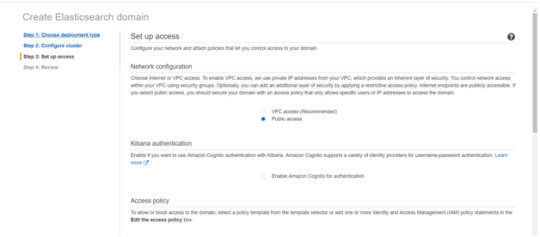
After the Cluster Configuration, you will be taken to the Set up access part. In the Setup access part, enable the specific set of users who can access your ElasticSearch cluster. There are two options — VPC access and Public access. Once you select one of the options and confirm your entries your new cluster is created.
Things to consider
1. Expandable
Amazon Elasticsearch Service provides to monitor your cluster through Amazon CloudWatch metrics.
We can change the cluster in various size from top or bottom within single clicks in the AWS management console or via a single API call.
There is a customizable setting available based on the range of instance types and storage options including SSD-powered EBS volumes.
2.Integrations
Many integrations available in the AWS Elasticsearch such as Kibana for data visualization, Amazon CloudTrail is used to audit API calls configure in AWS ES domains and integrate with Amazon Amazon S3, Amazon Kinesis, and Amazon DynamoDB for loading streaming data into Amazon ES.
3.Guarantee
It guarantees to provide a secure environment and easy integration with Amazon VPC and VPC security groups. There is an availability to access the Identity and Access Management (IAM) control. It provides authentication for Kibana and Data encryption with node-to-node encryption.
4.Availability
Amazon ES supports the different zones in two geographical locations and various node allocations with a large number of zones in the same region itself. It manages the cluster and notifies the damaged nodes automatically.
Conclusion
This article has covered what AWS Elastic Search means, its benefits, what happens between and how you can use it.
#AWS#Elasticsearch#LogAnalytics#SearchEngine#CloudComputing#DataVisualization#Kibana#Scalability#Security#CloudWatch#AWSIntegration#DataEncryption#VPC#ElasticCluster#API#CloudInfrastructure#TechSolutions#BigData#AWSElasticsearch#ElasticSearchService#DataAnalysis#CloudServices
0 notes
Text

This is the Value Proposition Canva and Business Model Canva of our AgriTECH Start Up; this is important for entrepreneurs and businesses looking to clearly define their offerings and strategies.
These visual frameworks help to articulate the unique value a product or service provides to customers and outline the core components of a business's operations. By using these canvases, you can gain a deeper understanding of your target market, develop compelling messaging, and create a sustainable business model. Please click the link to see: https://www.canva.com/design/DAGSqR6jDts/v1rGckcgWvXI2ijdh_gv1g/view?utm_content=DAGSqR6jDts&utm_campaign=designshare&utm_medium=link&utm_source=editor
1 note
·
View note
Text

Questions I asked:

What benefits do you expect from using modified paver blocks made with coconut fiber and rice husk in your construction projects? A sustainable product that is durable with less maintenance
How important is sustainability when selecting materials like paver blocks for your home or business? It's very important especially for the sake of the community.
What challenges do you face in finding eco-friendly paver block suppliers that meet your project requirements? It's not available in the market near my area.
Do you prioritize durability, aesthetics, or eco-friendliness when choosing paver blocks for driveways, pathways, or landscaping? Always, I want my home to be as pleasing as it can be.
How do price, installation and maintenance services for these modified paver blocks affect your decision to purchase them? I'd love to purchase cheaper products with high quality.

Insight:
In the construction industry, concrete is in demand due to the rapid urbanization and development of every country. Hence, the price of cement products has skyrocketed due to the demand and supply relationship. However, behind this booming demand lies a bigger problem that often gets overlooked: the negative health and environmental impacts of cement production. Research has shown that cement dust can cause lung cancer, asthma, and chronic bronchitis, aside from that it can also damage the environment. This may cause a ripple effect in the future, which we would like to avoid.
Therefore with problems like this, our team has decided to pitch an item that will help the industry to have a sustainable product that will somehow reduce the use of cement. Paver blocks for example are used to build patios, driveways, parks, and anything we can think of, making this cement product popular in the market. What if we could tweak their design to make them more eco-friendly and less reliant on cement? Incorporating waste materials such as coconut fiber and rice husk into paver blocks might help solve issues regarding waste materials and reduce the use of cement as a binder.
That said, we didn’t stop at brainstorming—we went out and asked consumers and business owners what they thought of the issue. Unsurprisingly, many expressed concerns about cement being hazardous. "While I was mixing concrete, I inhaled a few cement dust, which makes me cough a lot of times, " Richard, one of the workers constructing a residential building, said. He claimed that his exposure to cement somehow affected his health.
Let's be realistic, we can't fully eliminate cement in the construction industry since we need it to build infrastructures. As of the moment, we don't have any technology to replace it. The best alternative thing we can do is to reduce its usage. By doing so- Modified Paver Block can do that job very well. It functions as a regular paver block that we see every day, it's just that we adjusted the design mix while keeping in mind the integration and repurposing of coconut fiber and rice husk.
I believe that this solution might help consumers and construction companies to align their mission and vision to SDGs. I believe this will help the community and the environment for sure. The changes we make today, no matter how small, can help create a better tomorrow.
0 notes
Text
W5 - Customer Segments
As we interviewed individuals, we have identified the top three customer segments: landlords/property owners, who are the end-users or decision-makers; students, who are not only the main reason for this idea but also the end-users, decision-makers, and payers; and regular renters. We include regular renters because, although our marketplace primarily focuses on students, we recognize that students are not the only ones who will need this marketplace. Regular renters are also end-users, decision-makers, and payers. We also have a top 1 customer persona which is a student and we formulate VPC for 3, landlords, students, and regular renters.
0 notes
Text
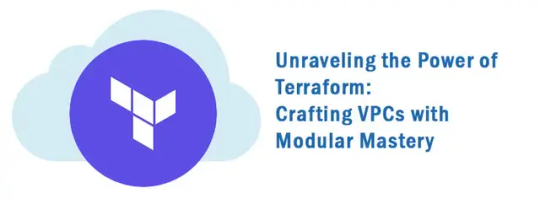
Step into the world of Terraform with our Modular VPC series! Dive into VPC creation, dynamic routing, and more on our DevOps journey. Empower yourself with SSL control and domain routing.
0 notes
